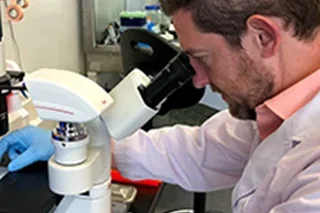Obesity & Diabetes
Metabolism, Obesity & Type 2 Diabetes
Two of the most common disorders are obesity and diabetes
Obesity and Type 2 diabetes – are metabolic disorders. Both are related to food: Obesity is connected to excessive body fat accumulation, and high blood sugar is connected to diabetes. Researchers in UCLA’s Metabolism Research Theme are studying the roots of these disorders and designing ways to treat them. Their strategies are novel. In the case of Type 2 diabetes, they are working with theories that could dramatically revamp conventional understanding of the disease’s cause.
Mitochondria Function As Little Power Plants
When Metabolism Theme leader Orian Shirihai, MD, PhD, talks about obesity, he envisions mitochondria (the power plants for cells) trying to deal with an excess nutrient environment.
Inside cells, tiny organs called organelles manage highly specialized tasks. Organelles are to the cells what organs are to the body – they function independently, but they are all connected. Mitochondria are a type of organelle that function as little power plants to handle the work of burning nutrients. When it comes to studying metabolism, mitochondria are the stars of the show.
Mitochondria continually change shape depending on whether they are “eating” sugar or fat. The process works this way:
- When a person fasts, mitochondria burn fatty acids to keep glucose high enough to prevent low blood sugar.
- After a person eats, mitochondria prefer to gobble glucose, this time to prevent blood sugar from becoming too high.
- When a person eats a lot of food somewhat steadily, mitochondria change shape continually as they work. They may have difficulty repairing and cleaning themselves after keeping the power plant blasting nonstop.
When organelles have problems repairing themselves, the result is a reduced ability to eliminate defective or toxic parts. For example, a toxic by product of cellular metabolism known as reactive oxygen species (ROS) bombards cellular proteins and membranes, damaging their structures. This stress can lead to a cornucopia of disorders. Learn more about mitochondrial quality control.
Studying Ways to Change Cells’ Nutrient Preferences
Dr. Shirihai and other members of the Metabolism Theme are trying to understand whether it is possible to make tissue prefer one nutrient to another. This process could help stem obesity, a condition that affects more than one-third of U.S. adults.
Metabolic processes in the cell store as many excess nutrients as possible in the form of fat. The cells build a warehouse of energy that might come in handy when a person eats too little.
To survive in the face of nutrient (fuel) loss, the cells in a person on a low-calorie diet become much more efficient. The cells need fewer calories to function.
For dieters, this efficiency means that after the first week and the loss of a few pounds, it becomes increasingly difficult to drop weight.
Investigator Spotlight
Understanding the links between obesity and cancer mortality. Studies have shown that obese people have a substantially higher risk of dying from cancer than nonobese individuals. However, the reasons for this association are not fully understood. Obese children who are diagnosed with the most common childhood cancer, acute lymphoblastic leukemia (ALL), have a ~50% higher risk of leukemia relapse after treatment than nonobese children.
The Mittelman Lab is committed to understanding why these children have a poorer outcome, and developing strategies to reverse this effect. “We have discovered that adipocytes protect ALL cells from several chemotherapies, making the leukemia harder to cure. We have also recently tested a diet and exercise intervention in children during ALL treatment which showed promising effects to improve treatment outcomes,” Dr. Mittelman explains. Our research has spans the translational gamut, including cell culture, preclinical models, clinical studies, and epidemiology.
Learn & Discover
“ ”



